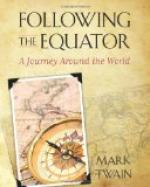Yes, when the Moment comes, the Man appears—even if he is a thousand miles away, and has to be discovered by a practical joke.
CHAPTER XXIX.
When people do not respect us we are sharply offended;
yet deep down in his private heart no man much respects
himself.
—Pudd’nhead
Wilson’s New Calendar.
Necessarily, the human interest is the first interest in the log-book of any country. The annals of Tasmania, in whose shadow we were sailing, are lurid with that feature. Tasmania was a convict-dump, in old times; this has been indicated in the account of the Conciliator, where reference is made to vain attempts of desperate convicts to win to permanent freedom, after escaping from Macquarrie Harbor and the “Gates of Hell.” In the early days Tasmania had a great population of convicts, of both sexes and all ages, and a bitter hard life they had. In one spot there was a settlement of juvenile convicts—children—who had been sent thither from their home and their friends on the other side of the globe to expiate their “crimes.”
In due course our ship entered the estuary called the Derwent, at whose head stands Hobart, the capital of Tasmania. The Derwent’s shores furnish scenery of an interesting sort. The historian Laurie, whose book, “The Story of Australasia,” is just out, invoices its features with considerable truth and intemperance: “The marvelous picturesqueness of every point of view, combined with the clear balmy atmosphere and the transparency of the ocean depths, must have delighted and deeply impressed” the early explorers. “If the rock-bound coasts, sullen, defiant, and lowering, seemed uninviting, these were occasionally broken into charmingly alluring coves floored with golden sand, clad with evergreen shrubbery, and adorned with every variety of indigenous wattle, she-oak, wild flower, and fern, from the delicately graceful ‘maiden-hair’ to the palm-like ‘old man’; while the majestic gum-tree, clean and smooth as the mast of ‘some tall admiral’ pierces the clear air to the height of 230 feet or more.”
It looked so to me. “Coasting along Tasman’s Peninsula, what a shock of pleasant wonder must have struck the early mariner on suddenly sighting Cape Pillar, with its cluster of black-ribbed basaltic columns rising to a height of 900 feet, the hydra head wreathed in a turban of fleecy cloud, the base lashed by jealous waves spouting angry fountains of foam.”
That is well enough, but I did not suppose those snags were 900 feet high. Still they were a very fine show. They stood boldly out by themselves, and made a fascinatingly odd spectacle. But there was nothing about their appearance to suggest the heads of a hydra. They looked like a row of lofty slabs with their upper ends tapered to the shape of a carving-knife point; in fact, the early voyager, ignorant of their great height, might have mistaken them for a rusty old rank of piles that had sagged this way and that out of the perpendicular.




